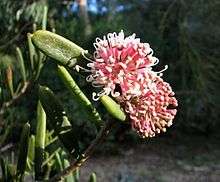Hakea clavata
| Hakea clavata | |
|---|---|
 | |
| Scientific classification | |
| Kingdom: | Plantae |
| Clade: | Angiosperms |
| Clade: | Eudicots |
| Order: | Proteales |
| Family: | Proteaceae |
| Genus: | Hakea |
| Species: | H. clavata |
| Binomial name | |
| Hakea clavata | |
Hakea clavata, commonly known as coastal hakea is a shrub that is endemic to an area along the south coast of Western Australia.
Description
The shrubby species is spreading or sprawling in habit, is has a lignotuber and is up to 2.5 metres (8 ft) wide and 0.5 to 2.0 m (1.6 to 6.6 ft) in height.[1] It has thick flattened evergreen leaves with a narrowly elliptic or obovate shape and a length of 2 to 8 centimetres (0.8 to 3.1 in) and a width of 4 to 11 millimetres (0.157 to 0.433 in).[2] The flowers are white and pink, appearing between January and October on the terminals of the branches.[1] Each inflorescence is composed of 60 to 80 flowers with a pink claw, grey limbs and white interior. Following flowering a woody obliquely ovate or obovate fruit which has a 1.5 to 2.5 cm (0.59 to 0.98 in) length and a width of 0.9 to 1.0 cm (0.35 to 0.39 in) with 3 to 5 mm (0.118 to 0.197 in) horns. The black-brown seeds within have an obliquely obovate shape and a length of 16 mm (0.630 in). Each seed has a broad wing along one side of seed body.[2]
Taxonomy
The species was first described in 1805 by Jacques Labillardière in Novae Hollandiae plantarum specimen. Labillardière may have made a type collection when at the Esperance region in December 1792.[3] The epithet clavata (Latin) refers to club-shape of the leaves.[1]
Distribution
It is found on the mainland an on some of the islands between Israelite Bay and Esperance, Western Australia and a single population is known at Hopetoun to the west[2] in southeastern areas of the Southwest Botanical Province where it is found in windswept places among granite outcrops growing in rocky sandy clay soils.[1]
References
- 1 2 3 4 "Hakea clavata Labill". FloraBase. Western Australian Government Department of Parks and Wildlife.
- 1 2 3 "Hakea clavata". Fact Sheet. Government of South Australia. Retrieved 11 October 2018.
- ↑ Hopper, Stephen (2003). "South-western Australia, Cinderella of the world's temperate floristic regions 1". Curtis's Botanical Magazine. 21 (2): 132–179. doi:10.1111/1467-8748.00380.